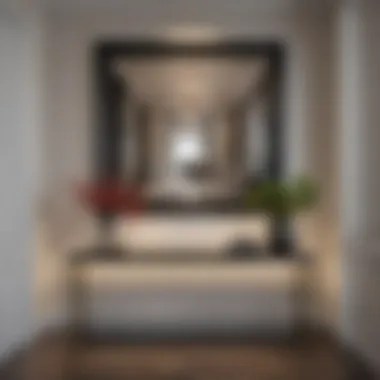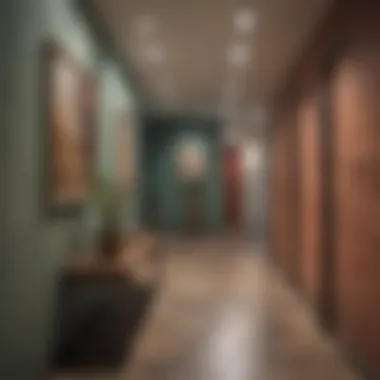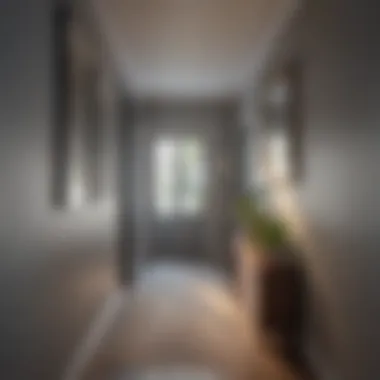Hallway Inspirations: Design and Functionality


Intro
Hallways often miss the spotlight in interior design. They are typically seen as mere conduits from one room to another. However, the potential for transformative design is immense. This article aims to shift the perspective on hallways, encouraging homeowners and design enthusiasts to explore possibilities that enhance both aesthetic and functionality. By evaluating trending styles, effective color palettes, and appropriate furnishings, this piece will delve into how to elevate these essential yet overlooked areas of residential spaces.
Design Inspirations
Trending Styles
When thinking about hallways, various design styles can influence the overall look. Popular trends include:
- Minimalism: Clean lines, uncluttered spaces, and a focus on functionality define this approach. Furniture and decor are kept to a minimum, allowing the hallway to breathe and remain welcoming.
- Industrial: Characterized by raw materials like metal and wood, this style brings an urban edge. Exposed pipes, brick walls, and metallic accents can create a striking visual effect.
- Cottage: This style offers warmth and comfort through soft colors, vintage furnishings, and personal touches. It evokes a sense of home, making hallways feel inviting.
- Modern Farmhouse: Combining rustic charm with sleek lines, this blend appeals to those who appreciate both tradition and contemporary design.
Exploring these styles will provide a foundation for personal expression in hallway design. Each offers its own unique character, allowing for tailored choices based on individual preferences and the overall theme of the home.
Color Palettes
Color selection plays a key role in hallway transformation. The right palette can set the mood or tone for the entire space. Consider applying these principles:
- Neutrals: Shades like beige, gray, and white offer a timeless look. These colors can make spaces feel larger and airier, suitable for narrow hallways.
- Bold Accents: Adding splashes of bold color like deep blues or vibrant greens in portions of the hallway can create focal points and visual interest. Consider using these colors on a single wall or as accents in artwork.
- Pastels: Soft pinks, blues, and greens lend a delicate touch, serving to calm and soothe. These colors often work well in conjunction with cleaner, more modern styles to create harmony.
- Monochrome: Sticking to a single color but varying its shades can add depth without overwhelming the senses.
Ultimately, color palettes not only reflect personal style but can also affect how one feels when passing through these transitional spaces.
Maintenance and Upkeep
Maintaining a hallway's design integrity is crucial for its functionality and aesthetic appeal. A few simple maintenance strategies can ensure that the hallway remains inviting.
Seasonal Maintenance Checklist
Developing a seasonal checklist can streamline upkeep. Here are key points to consider:
- Inspect Walls: Look for scuff marks or damages. Touch up paint as needed to keep walls fresh.
- Declutter Space: Regularly remove items that accumulate in hallways. This ensures that the area remains functional and visually appealing.
- Lighting Checks: Ensure fixtures are clean and bulbs are functional. Consider seasonal changes in lighting needs.
- Floor Care: Depending on the flooring material, establish a cleaning routine. Avoiding wear and tear is essential for maintaining beauty and functionality.
Cleaning and Organization Tips
A clean and organized hallway maximizes its potential. Implement these practical tips:
- Use designated storage solutions like baskets or bins to organize shoes and outerwear.
- Incorporate wall hooks for coats or bags to reduce clutter.
- Consider rugs that can be easily cleaned and enhance the hallway’s design.
Keeping the hallway maintained with such strategies will not only improve daily function but also enhance the overall home experience.
"Hallways can be a canvas for creativity and style. They are opportunities to express personality beyond common areas."
Attending to design elements and maintenance encourages homeowners to embrace their hallways as integral parts of their living spaces.
Understanding Hallways Within the Home
The hallway serves a critical role in the overall layout of a house. It acts as a conduit between various spaces, providing not only access but also contributing to the flow of the home's design. In this article, we will explore the significance of hallways, considering their potential for both aesthetic appeal and function. Various design elements can enhance the perception of space and create a harmonious atmosphere.
By appreciating hallways, homeowners and designers can unlock the potential of these often overlooked areas. Instead of viewing hallways solely as passageways, recognizing their place in spatial design transforms them. They can become vibrant extensions of a home, capable of reflecting personal style and fostering utility.
The Role of Hallways in Spatial Design
Hallways play an important part in spatial configuration within the home. They can dictate how one moves within the space, affecting the experience of both residents and visitors. A well-designed hallway connects rooms seamlessly while also breaking the visual monotony of the house.
Effective hallway design can lead to increased light flow, better circulation, and even an expansion of perceived space. The choices in materials, colors, and decor influence how inviting a hallway feels. A narrow hallway may benefit from lighter tones and reflective surfaces, while a broad one could accommodate more substantial artworks or furniture. This enhances both function and visual interest.
Historical Perspectives on Hallway Design
The design of hallways has evolved considerably throughout history. In earlier centuries, hallways were often grand, with elaborate moldings and ceiling heights, showcasing wealth and status. Homes had wide corridors that served as social spaces, often adorned with paintings or family heirlooms, conveying a sense of history and pride.
During the 20th century, with modernism's rise, hallways began to adopt a more functional approach. Less emphasis was put on ornamentation, and instead, simplicity and clean lines took priority. This shift reflected changing lifestyles and the need for practicality in domestic spaces.
Today, historical insights can inform contemporary designs by blending elements of the past with modern needs. Understanding how hallways have been used provides context for current trends, allowing designers to create spaces that are both functional and rich in character.
Design Styles for Hallways
Design styles for hallways play a crucial role in how these often-overlooked spaces are perceived and integrated within the broader context of home design. Hallways function not only as transitional pathways but also as opportunities for creative expression. They can reflect the design ethos of the entire home while serving practical purposes. By selecting an appropriate design style, homeowners can enhance their hallways, making them visually appealing and functional.
When considering design styles, homeowners should think about harmony throughout their interiors. A well-thought-out style can unify various areas of the home. The choice of style influences aspects like lighting, color palettes, and furnishings, all of which contribute to creating an inviting atmosphere that eases movement and encourages exploration of the space.
Contemporary Designs
Contemporary designs focus on the here and now, incorporating current trends and innovative materials. This style often emphasizes clean lines, open spaces, and minimalistic decor. In the hallway, contemporary designs manifest through the use of sleek furniture and a muted color palette.
Wall-mounted shelves can serve both as storage and display for modern art pieces, while light fixtures are often minimalist and strategically placed to enhance natural light. The goal is to create a sense of spaciousness and clarity, allowing the hallway to function efficiently while making a bold visual statement.
Classical Inspirations
Classical inspirations evoke a sense of timeless elegance. This design draws from historical references, featuring ornate moldings, rich materials, and elaborate details. In a hallway designed with classical elements, one might find wainscoting along the walls or decorative cornices.


Color schemes in classical designs often include deep, rich hues or light, airy pastels, providing an opulent backdrop. Furniture may have intricate carvings or luxurious fabrics, making the transition from room to room feel grand and sophisticated. The use of symmetry is also prevalent, enhancing the sense of balance within the space.
Rustic and Industrial Aesthetics
Rustic and industrial aesthetics bring an organic, raw appeal to hallways. Rustic designs often include reclaimed wood, natural textures, and earthy colors, evoking a cozy, homely feel. Incorporating elements like exposed beams or stone walls can effectively blend with industrial elements like metal fixtures and minimalist decor.
In hallways, these styles can create a unique environment that feels warm while still maintaining a modern edge. Just by adding some vintage light bulbs or a simple wooden bench, a hallway can shift from ordinary to extraordinary without much effort.
Minimalist Approaches
Minimalist approaches in hallway design emphasize simplicity and functionality. The core philosophy is to declutter and only keep what is necessary. This can lead to a serene space that fosters calm and clarity.
In the hallway, this may show as crisp white walls, subtle textures, and only essential furniture like a single console table or a slim seating option. Minimalist designs often incorporate hidden storage solutions to maintain a clutter-free environment.
Utilizing a neutral color palette enhances the sense of space and light.
"Less is more" is the guiding principle in minimalist design, allowing hallways to shine through their simplicity.
By properly choosing and implementing these design styles in hallways, homeowners can transform these areas into meaningful extensions of their living spaces.
Color Palettes for Hallway Design
Color plays a crucial role in hallway design and can significantly influence the perception of space. It can set the tone for the entire home, making hallways more inviting or spacious. Choosing the right color palette allows homeowners to enhance both aesthetic appeal and functionality. Hallways, often seen as mere transitional areas, can be transformed into striking features through thoughtful color choices.
Neutral Tones and Their Impact
Neutral tones serve as a versatile canvas in hallway design. These colors can create a sense of calm and cohesion throughout the home. Shades like beige, gray, or soft whites blend well with various design styles, making them a popular choice. They allow the architecture and decor of the hallway to stand out without overpowering the space.
Using neutral tones also has practical advantages. For smaller hallways, light neutrals can visually expand the space, giving the illusion of width and depth. In contrast, darker neutral shades offer sophistication and warmth. they can make larger hallways feel cozier without losing their elegance. Incorporating textures and materials in neutral tones can further add depth, preventing the space from feeling flat.
Bold Colors for Dramatic Effect
On the opposite end of the spectrum, bold colors can create a striking impact in a hallway. Bright hues like deep blues, vibrant reds, or vivid greens can inject personality into the design. These colors serve as a focal point, drawing the eye and creating memorable first impressions. When a homeowner opts for a bold color, it’s important to consider the overall flow of the house.
Using bold shades can create emphasis on specific architectural features. For example, painting the end of a long hallway in a bold color can create a sense of depth and visual interest. However, it is vital to balance these colors with complementary elements. Using art, decor, or furnishings that harmonize with bold colors enhances the overall effect without overwhelming the space.
Creating Cohesion with Color Schemes
Creating cohesion within a home involves choosing a color scheme that works seamlessly throughout the various spaces, including hallways. Cohesiveness ensures that each area transitions smoothly into the next, fostering a unified aesthetic. One effective method is to select a palette that includes a mix of neutral tones and a few accent colors.
For instance, homeowners can use a base of soft greys with pops of color through decorative elements, such as artwork or furnishings. Alternatively, one might choose a bolder palette throughout the home while toning it down in transitional areas like hallways. This way, hallways ease the transition between vibrant spaces, maintaining visual harmony.
A key consideration is understanding the psychology of color. Different colors evoke different emotions, and this is vital when designing hallways, which are often high-traffic areas. Homeowners should strive for an environment that is not only visually appealing but also creates the desired emotional response.
A well-thought-out color palette can elevate the functionality of hallways, transforming them into visually cohesive and inviting spaces.
Lighting Considerations in Hallways
Hallways serve as the arteries of a home, facilitating movement between spaces. Therefore, the role of lighting in these corridors cannot be overstated. Proper illumination enhances safety, defines architecture, and can dramatically affect the emotional tone of the area. In addition, well-lit hallways augment the overall aesthetic of the home, making them inviting rather than utilitarian. As more people recognize hallways as spaces of potential, understanding lighting considerations becomes essential.
Natural Light Enhancement
Maximizing natural light in hallways can significantly elevate the mood of the space. This begins with strategic placement of windows and the use of glass doors. Large windows or skylights can bring in daylight, making narrow or darker hallways appear more spacious and vibrant. When planning new constructions or renovations, it is advantageous to consider these elements from the start.
- Use clear glass panes where possible to ensure unobstructed light flow.
- Incorporate mirrors opposite windows to reflect and amplify the light, creating an illusion of depth.
- Choose lighter wall colors to enhance the brightness that the natural light provides.
Natural light not only improves visibility but can also improve mood and well-being. In contexts where windows are not feasible, consider utilizing light tubes that collect sunlight from the roof and deliver it to darker areas, offering a practical solution to enhance illumination without electric lighting.
Artificial Lighting Solutions
In case natural light is limited or nonexistent, artificial lighting solutions step in to fill that void. A balanced layering of light sources ensures functionality without overwhelming the senses. Employing different types of light fixtures can adapt to the specific needs and style preferences of homeowners.
- Wall sconces provide ambient light and can add character to the walls.
- Recessed lighting minimizes clutter and keeps the lines clean, making it suitable for modern designs.
- Track lighting allows flexibility in focusing light where needed, ideal for hallways featuring artworks or decor that deserves attention.
Choosing LED fixtures can lead to energy efficiency while also providing ample brightness. Moreover, the design of light fixtures should match the overall hallway theme, creating a cohesive design flow throughout the home.
Layering Lighting for Effect
Layering lighting involves combining ambient, task, and accent lighting to create a harmonious atmosphere. This strategy is particularly effective in hallways, where one type of light might not suffice. Different approaches enhance both form and function, making the hallway an engaging space rather than just a transition.
- Ambient Lighting: This is the primary source of light, setting the overall brightness. For hallways, it could be achieved through ceiling-mounted fixtures.
- Task Lighting: Specifically focuses on areas where tasks are performed. In hallways, this could include brighter spotlights aimed at artwork or entryway details.
- Accent Lighting: Designed to highlight features. A small light directed at a unique architectural element or decor piece can create visual interest.
Layering creates depth and variability and can effectively convert a stark corridor into a visually stimulating environment, making each journey through the hallway feel fresh.
Functional Design Elements
In the context of hallway design, functional elements are crucial. They transform a basic transit space into a well-organized and purposeful area. Homeowners often overlook hallways, but with thoughtful design, these spaces can enhance the home’s overall functionality and aesthetics.
Creating Storage Solutions


Hallways often provide limited space for storage. However, integrating clever storage solutions can make a significant difference. Consider using built-in shelves or cabinets. These can be tailored to fit under staircases or along narrow walls. Using vertical space is essential to maximizing storage in hallways.
- Under-Bench Storage: A bench with hidden compartments can serve dual purposes. It offers a place to sit while putting on shoes, and provides storage for bags or seasonal items.
- Wall-Mounted Shelves: These allow for decorative storage. Books, plants, or small decorative items can bring character to a hallway while keeping the floor clear.
- Hooks and Racks: Incorporating hooks for coats and racks for bags is practical. This setup minimizes clutter and keeps items organized in a convenient spot.
Each of these storage solutions enhances usability without sacrificing style. Opt for materials that match the overall decor of the home to maintain a cohesive look.
Incorporating Seating Arrangements
Seating in a hallway can change its function substantially. An inviting bench or a set of stools can create a more welcoming atmosphere. While hallways serve as passageways, integrating seating solutions encourages pause and interaction.
- Nook Creation: If space allows, dedicate an area for a small seating nook. A cozy chair or a bench with cushions creates an inviting spot for relaxation or conversation.
- Furniture Selection: Choose furniture that complements the existing style of your home. For a modern hallway, sleek lines work well, while rustic designs suit more traditional homes.
- Multipurpose Furniture: This can be very useful in limited spaces. For example, a storage bench serves as both a seat and a functional storage solution.
When selecting seating arrangements, consider the overall flow of the hallway. It is important to avoid overcrowding, ensuring the space remains navigable and comfortable.
Effective Use of Wall Space
Wall space presents an opportunity for creativity in hallway design. From display options to functional installations, optimizing this area enhances both storage and aesthetics.
- Wall Art and Photographs: Personal touches through framed art or family photos can infuse warmth into a hallway. They act as conversation starters and provide a sense of home.
- Functional Installations: Consider wall-mounted organizers. These can hold mail, keys, or small items, reducing clutter.
- Lighting Fixtures: Using sconces or minimalist light fixtures can draw attention to the walls and add ambiance.
The efficient use of wall space is not just practical; it embodies thoughtful design that tells a story about the home and its inhabitants.
"A hallway is more than a connection between rooms; it's an expression of how one transitions through spaces, making functional design elements essential."
In summary, functional design elements like storage solutions, seating arrangements, and wall space optimization are vital for transforming hallways. They elevate the space from a simple corridor to a well-organized and welcoming extension of the home.
Decor and Personal Touches
Decor and personal touches play a significant role in transforming hallways from mere connectors into showcases of individual style. This section examines how thoughtful decorations can make hallways more inviting and functional. Specific elements like art, mirrors, and plants can enhance the aesthetic value while offering practical benefits.
Art and Wall Decor Ideas
Art and wall decor can redefine a hallway's character. Rather than leaving walls blank, curated pieces can create focal points. This can range from framed artwork to family photos that convey personal stories. When selecting art, consider the scale; larger pieces can create a bold statement, while smaller works may be arranged in a gallery style for a more intimate feel.
In addition to art, wall decor like tapestries or textured panels can introduce depth and warmth. Vertical placements of art work best in narrow hallways, drawing the eye upward and creating an illusion of space. Moreover, you can switch displays seasonally to keep the decor fresh and relevant.
Using Mirrors to Enhance Space
Mirrors are powerful tools in hallway design. They can increase the perception of space and light, making narrow or dimly lit hallways feel broader and brighter. Wall-mounted mirrors, particularly those with decorative frames, add a touch of elegance while serving a practical purpose. When positioning mirrors, consider placing them opposite windows or light sources; this maximizes natural light and contributes to an overall approachable ambiance.
Additionally, mirrors can serve as a way to reflect artwork or other decor, creating an interesting visual dialogue. They can be layered to create depth, and can be strategically placed to allow for last-minute checks before heading out. This functionality cannot be overstated; it doubles as decor and utility.
Plants and Greenery in Hallways
Incorporating plants adds vibrancy and life to hallways. Greenery can soften hard surfaces and bring nature indoors, promoting a pleasant atmosphere. Choosing low-maintenance plants such as snake plants or pothos makes this an accessible choice for even the busiest households. You can use wall planters, hanging pots, or floor vases to introduce organic shapes and colors.
Plants in hallways also improve air quality and contribute to an overall sense of well-being. They can be placed in corners or on console tables, providing softness against the backdrop of walls. Consider creating a small indoor garden in larger hallways, or using trailing plants to create a cascading effect.
"Incorporating personal touches not only enriches hallway aesthetics but also reflects the homeowner's identity."
The use of decor and personal touches ultimately elevates the hallway experience. Key considerations such as art selection, mirror placements, and plant choice can substantially enhance the visual appeal and functionality of these transition areas.
Space Optimization Techniques
Space optimization in hallway design is essential because it directly impacts not only the flow of movement but also the overall functionality of the home. Hallways in homes serve as pathways, connecting different areas and providing transit space. However, they can also become valuable areas for storage, decor, and other functional elements. When well-thought-out, these spaces can elevate both the design and usability of a home.
Incorporating effective space optimization techniques can significantly enhance the aesthetics and practicality of narrow and expansive hallways alike. Key benefits include increased storage solutions, improved visual flow, and an enriched ambiance. Homeowners should consider creative ways to integrate shelves, hooks, and trendy decor without cluttering the area. Here are specific strategies for optimizing hallway space:
Tips for Narrow Hallways
Narrow hallways present unique challenges but also offer opportunities for innovative solutions. Utilizing every inch is critical in ensuring that the space remains functional yet stylish.
- Use Vertical Space: Install shelves that reach the ceiling. This enhances storage without encroaching on floor space. Consider wall-mounted shelves in simple designs that offer storage for books or decorative elements.
- Color Choices and Mirrors: Light and neutral colors can make a narrow hallway feel more spacious. Mirrors strategically placed can also create an illusion of depth, projecting light and enhancing the visual impact of the hallway.
- Slim Furniture Options: If adding furniture, choose narrow tables or slim benches that do not obstruct pathways. These pieces can serve practical purposes without overwhelming the space.
- Art Arrangement: Instead of crowding the walls, space out art pieces. This allows a streamlined view that draws attention away from the narrowness.
Maximizing Tall Ceilings
Tall ceilings in hallways should be seen as an advantage, rather than a challenge. When utilized effectively, they can add grandeur and character to these transitional spaces. Here are ways to make the most out of high ceilings:
- Crown Molding: Adding crown molding can draw the eyes upward, accentuating the height and creating a polished appearance. Select designs that reflect the overall style of the home.
- Long Vertical Art or Shelving: Art pieces that extend vertically can highlight the height of the space. Similarly, tall bookcases or shelving can showcase decor, books, or plants strategically suited for the room's dimensions.
- Lighting Fixtures: Pendant lights or chandeliers that hang from above can create an inviting atmosphere. Properly positioned lighting can illuminate the hallway while enhancing its design.
- Plant Display: Tall planters or hanging plants add that touch of greenery and can also draw the eyes up, making the space feel energized.
Achieving effective space optimization in hallways requires creativity and thoughtfulness. By leveraging the unique characteristics of the space, homeowners can transform their hallways into well-designed areas that serve multiple purposes while maintaining visual appeal.
Seasonal Decor for Hallways
Seasonal decor is an essential consideration in hallway design. Hallways often serve as the first impression of a home, making them prime candidates for seasonal updating. Changing decor according to the seasons allows homeowners to bring a fresh perspective and vitality to these transitional spaces. It can enhance the overall aesthetic of a home, create a warm atmosphere, and reflect personal style or seasonal trends.
Incorporating seasonal themes can also invite a sense of continuity with the changing environment outside. Whether it is the blossoming flowers of spring or the warm hues of autumn, reflecting these elements in hallways can create a harmonious alignment with nature. This is particularly relevant for design enthusiasts who wish to make their interiors feel more connected to the outside world.
From simple accents to more elaborate decorations, the benefits of seasonal decor can transform a mundane hallway into a vibrant and welcoming area. Attention should also be given to the balance between aesthetics and functionality. Keeping pathways clear while introducing seasonal elements is vital to maintaining a practical flow of traffic in the home.


Spring and Summer Inspirations
Spring and summer provide ample opportunities to refresh hallway decor. Key elements to consider for these warmer months include bright color palettes, light materials, and natural textures.
- Floral Accents: Incorporating floral designs or real flowers can instantly brighten a hallway. Vases filled with tulips or daisies evoke a sense of life and vitality.
- Light Fabrics: Changing out heavier curtains for airy sheers can allow more natural light to filter through, enhancing the space's vibrancy.
- Bright Colors: Using light yellows, soft pinks, or vibrant greens can lift the mood. These colors reflect the brightness of the season and can be introduced through wall art or decorative accents.
- Outdoor Themes: Utilizing decor that reflects outdoor experiences, such as small potted herbs or beach-themed decorations, can also invoke the feeling of summer.
Consideration must also be given to practical elements such as ensuring that the air circulation in the hallway remains adequate. Implementing features such as ventilation or strategically placed mirrors can help achieve this.
Fall and Winter Themes
As seasons change to fall and winter, the decor shifts to create a cozy and inviting atmosphere. The focus during these months often revolves around deeper tones, layered textiles, and warm lighting.
- Warm Color Schemes: Rich reds, deep oranges, and earthy browns can transform a hallway into a warm haven. This can be achieved through wall paint, rugs, or decorative elements.
- Layered Textiles: Rugs and throws can provide warmth. Textiles with seasonal patterns, like plaid for winter, evoke comfort and can add depth to the design.
- Ambiance with Lighting: The use of warm white light bulbs or decorative lanterns can enhance the seasonal feel. Wall sconces could also be used to strategically light pathways while maintaining a warm ambiance.
- Seasonal Cuttings: Incorporating branches or pine cones can give a nod to nature’s seasonal changes.
Ultimately, seasonal decor is more than mere aesthetics; it is about engaging the senses and fostering an environment that aligns with the current time of year.
Seasonal decorating effectively creates a narrative in your home, one that continues to unfold with each transitioning season.
Sustainability in Hallway Design
Sustainability in hallway design has gained importance in recent years. As homeowners strive to create interiors that are not only beautiful but also environmentally friendly, hallways become relevant spaces for implementing sustainable practices. The benefits are twofold: enhancing the aesthetic appeal of a home while also contributing positively to the environment. Sustainable design considerations lead to reflections on material choices, energy efficiency, and the overall carbon footprint of construction and decorating decisions.
Using eco-friendly materials offers significant advantages. Not only does it reduce environmental impact, but it also promotes healthier living spaces. Natural materials, such as wood from sustainable sources or bamboo, add warmth and texture to hallways. Additionally, considering low-VOC paints and finishes can improve indoor air quality. These small changes in design choices can lead to healthier environments for families.
Eco-Friendly Materials and Practices
When selecting materials for hallway design, prioritizing sustainability can lead to beautiful outcomes. Recycled materials, such as reclaimed wood or recycled glass, can create striking features. Such options reduce waste and provide unique character to a space.
In terms of flooring, consider cork or bamboo. Both materials are renewable and offer durability. Cork has the added advantage of being naturally antimicrobial, which benefits indoor health. In addition, using non-toxic adhesives and finishes while decorating can enhance the eco-friendliness of the design process further.
Practical implementation of sustainable features can include LED lighting, which provides energy-efficient illumination. Incorporating motion sensors for lighting can also help to minimize unnecessary energy use in hallways.
Repurposing and Upcycling Ideas
Repurposing and upcycling are effective ways to enhance hallways sustainably. Not only does this practice reduce waste, but it also allows for creative expression.
Consider transforming an old ladder into a rustic shelf for displaying plants or books. This functional decor adds charm while staying true to eco-friendly principles. Likewise, utilizing vintage furniture pieces can lend character and history to the space, making a strong personal statement.
Another simple idea is to use jars or containers for organizing small items like keys or mail. Instead of buying new items, finding creative ways to use what you already own can be satisfying. This approach often leads to one-of-a-kind designs that reflect individual style.
Overall, sustainability in hallway design urges us to rethink our choices, appreciate the environment, and embrace creative solutions that blend functionality with eco-consciousness, enhancing both our living spaces and the planet.
Integrating Technology in Design
Incorporating technology into hallway design is increasingly important in modern homes. It serves not just to beautify a space but also to provide functionality and security that enhances everyday living. As homeowners become more tech-savvy, they look to integrate cutting-edge solutions that can streamline their routines while maintaining aesthetic appeal. This section discusses how technology can elevate hallway design by focusing on smart lighting and security features.
Smart Lighting Solutions
Smart lighting has revolutionized the way we illuminate our homes, including hallways. This approach allows homeowners to control their lighting through apps and voice assistants, providing convenience for busy lifestyles. Here are some benefits of smart lighting:
- Energy Efficiency: Smart bulbs often use less energy compared to traditional incandescent bulbs. This can lead to significant savings on electricity bills.
- Customization: Homeowners can adjust brightness and color temperature to suit different moods or occasions. For instance, warm lights create a cozy atmosphere during parties while bright lights enhance safety during quick transitions at night.
- Enhanced Security: Many smart lighting systems include motion sensors that automatically turn on when someone approaches. This adds an extra layer of safety, illuminating dark areas and deterring potential intruders.
When selecting smart lighting products, consider the compatibility with your existing systems. Philips Hue and LIFX are well-known brands that offer a wide range of smart bulb options. Installing these products may require a bit more technical know-how, but the long-term benefits make it worth the effort.
Security Features and Design
Security in the hallway is a crucial aspect that should not be overlooked. Hallways often serve as access points to various rooms, making them critical zones for safety and protection. Integrating security features can bring peace of mind to homeowners. Possible solutions include:
- Motion-Activated Cameras: Installing cameras at key points in the hallway can monitor activity, providing a record of who enters and exits. These devices can often be linked to mobile apps for remote access, allowing homeowners to check in at any time.
- Smart Locks: Keyless entry systems are gaining popularity. They eliminate the need for physical keys and can often be programmed to allow access at specific times. This is ideal for guests or service providers without compromising security.
- Alarm Systems: Many modern alarm systems now integrate with smart devices. Homeowners can set, monitor, and manage alarms from their smartphones, making it easier to maintain security on the go.
Integrating these features requires careful consideration of placement and usability. Ensure that devices are easily accessible and blend in with the design of the hallway. With the right combination of technology, hallways can be transformed into not only functional spaces but also fortified areas that enhance the overall safety of the home.
"Smart technology is about improving our lives and habits. In hallways, it can make a significant impact."
By focusing on technology, homeowners can elevate their hallways and enhance both practicality and safety. As residential design continues to evolve, integrating these advancements will remain a crucial aspect of developing modern, functional living spaces.
The Future of Hallway Designs
The concept of hallways is evolving, moving away from being merely functional transitions to becoming important design elements within the home. As more homeowners recognize the potential of these spaces, there is a significant push to integrate innovative designs that focus on both aesthetics and utility. The future of hallway designs promises to encompass a balance between style and functionality, addressing the changing needs of modern families and lifestyles.
Innovative technology, eco-friendliness, and personalized touches are shaping the way hallways are designed. It is essential for designers and homeowners to consider how these elements will adapt to the increasing demands for sustainability and smart home integration. The future of hallway designs is not just about the physical space but how it fits into the broader context of the home as a whole.
"Hallways are no longer just a means to an end. They are becoming a canvas for creativity and practicality in our homes."
Emerging Trends to Watch
In the coming years, several trends are poised to redefine how we think about hallway spaces. One notable trend is multifunctional spaces. Hallways can serve multiple purposes, such as a small workspace or a mini-gallery for art and photographs. This can be especially beneficial in smaller homes where maximizing space is crucial. Another trend is the integration of smart technology. Features like smart lighting can enhance both convenience and safety, adapting to the homeowner's needs and preferences.
Sustainability is also gaining traction in hallway design. Homeowners are seeking out eco-friendly materials that reduce their carbon footprint while maintaining aesthetic appeal. For instance, using bamboo flooring or recycled wallpaper can contribute to a more environmentally conscious home.
Innovative Materials and Techniques
The materials used in hallway designs are evolving as well. Homeowners are looking for durable and sustainable options that can withstand heavy foot traffic. Advancements in materials mean that options such as high-performance vinyl or composite woods can mimic the look of natural materials without the associated environmental impact.
Additionally, the use of 3D printing technology is starting to influence hallway furnishings and décor. Custom pieces can now be tailored specifically for a hallway’s unique dimensions and style. This innovation allows for greater creativity and adaptability in design.
In terms of techniques, the application of layering can create depth and interest in hallways. Different textures and finishes can be combined on walls or ceilings, producing a visually compelling environment. With the right balance, designers can use these innovative materials and techniques to ensure hallways remain not just transitional but integral parts of the overall home environment.







